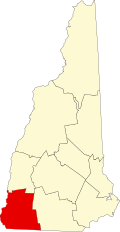Description and history
The Micajah Martin House stands in a rural setting in eastern Dublin, at the western end of Old Peterborough Road near its junction with New Hampshire Route 101. It is a 1+1⁄2-story timber-frame structure, with a gabled roof, clapboarded exterior, and large central chimney. Its main facade is five bays wide, with a center entrance that is framed by sidelight windows. A series of ells extend to the rear, joining the house to a barn. Gabled dormers, also a later addition, project from the front roof face. [2]
The house was built about 1802, probably by Micajah Martin, replacing the log house that was the first on the property, and is typical of the farmhouses built in Dublin in that period. It has retained its original fireplace and beehive oven, and features wooden paneling recovered from a now-demolished house of the same period. The house was bought by historian Frederick Lewis Weis in 1951, and was still in that family when it was listed on the National Register in 1983. [2]
This page is based on this
Wikipedia article Text is available under the
CC BY-SA 4.0 license; additional terms may apply.
Images, videos and audio are available under their respective licenses.



